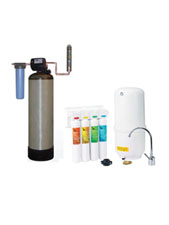|
|||||||||||||||||||||||||||||||
|
* One 20 inch Big Blue sediment filter. * The sediment filter housing is made out of high density polypropylene with pressure relief buttons. * The sediment filter dimensions: 29" high and 5" deep. * Weight of the sediment filter: 13lbs. * One 1.0 cubic foot backwashable carbon tank. * Tank Dimensions: 8" deep and 57" in height. * Tank weight: 45 lbs. * The tank has a control valve on the top that is automatically programmed to backwash and regenerate the carbon. * Grounded electrical outlet (GFI) needs to be available near installation. * Shut off and back flow valves and pressure gauges are to be supplied by plumber. * The tanks are backwashable and are installed where the main pipe enters the house at the water meter. If there is no basement the units can be installed next to the hot water heater. * Point of use reverse osmosis system. Reverse Osmosis Specifications: * 50 Gallons Per Day (gpd). * 4.0 Gallon plastic storage tank. * Tank dimensions: height 17" and width 9". * Color coded cartridges connect directly to the unit by a simple 1/4 turn. * Filter housings are eliminated. No mess during cartridge replacement! * Internal valves automatically shut-off flow when cartridges are removed. * Cartridges have double o-rings so they won't leak. * Compact design, so the unit requires less space below your sink! * All components are an integral part of the unit, which requires fewer tube connections for greater reliability. * Filter Dimensions: 10" x 10" x 3" * 35-100 PSI Operation Pressure. PSI > 80 requires pressure regulator. * Typical rejection rate 98% (total dissolved solids). * The sediment filter will remove particles, dirt, rust, sand and organic materials (sludge, leaves, roots, etc.). * The Reverse Osmosis System will filter up to 50 Gallons Per Day (gpd). The following is a partial list of items the RO system will reduce: calcium 93-98%, sodium 92-98%, magnesium 93-98%, perchlorate 94-96%, potassium 92-96%, manganese 96-98%, iron 96-98%, aluminum 96-98%, copper 96-98%, cadimium 93-97%, silver 93-96%, mercury 94-97%, chloride 92-95%, ammonium 80-90%, bromide 90-95%, cyanide 85-95%, sulfate 96-98%, nitrate 90-95%, borate 30-50%, fluoride 92-95%, chromate 85-95%, lead 95-98%, hardness Ca & Mg 93-97%, radioactivity 93-97%, polyphosphate 96-98%, orthophosate 96-98%, silica 80-90%, and boron 50-70%. * The 1.0 cubic foot backwashable carbon tank contains a blend of activated coconut shell and catalytic carbon. *The first stage of the RO system is a polyester pre-filter designed to remove large particles before they reach the sediment filter. * The second stage is the 5 micron sediment filter that traps sediment and other particulate matter like dirt, silt and rust which affect the taste and appearance of your water. *The third stage is the heart of the reverse osmosis system, the RO membrane. This semi permeable membrane will effectively take out total dissolved solids, sodium and heavy metals as well as cysts, such as giardia and cryptosporidium. *Because the process of making this high quality drinking water takes time, your RO water treatment system is equipped with a storage tank. *The fourth stage is an inline granular activated carbon (GAC). This filter is used after the water storage tank, and is used as a final polishing filter. * The sediment filter should be changed every year. * The R/O sediment filter should be changed every 6 months. * The R/O post filter should be changed every 12 months. * The R/O pre-filter should be changed every 6 months. * The R/O membrane should be changed every 2 years. There is a 1-year manufacture warranty on housing and component parts. |
|
|||||||||||||||||||||||||||||













 Enlarge Image
Enlarge Image